AFLW history in the making
After 25 years of men’s Showdowns, the first AFLW Crows-Port derby will be played tonight at Adelaide Oval. A Crows star tells Michelangelo Rucci about being a part of the league’s rise, with honest insights about what it’s getting right – and wrong.

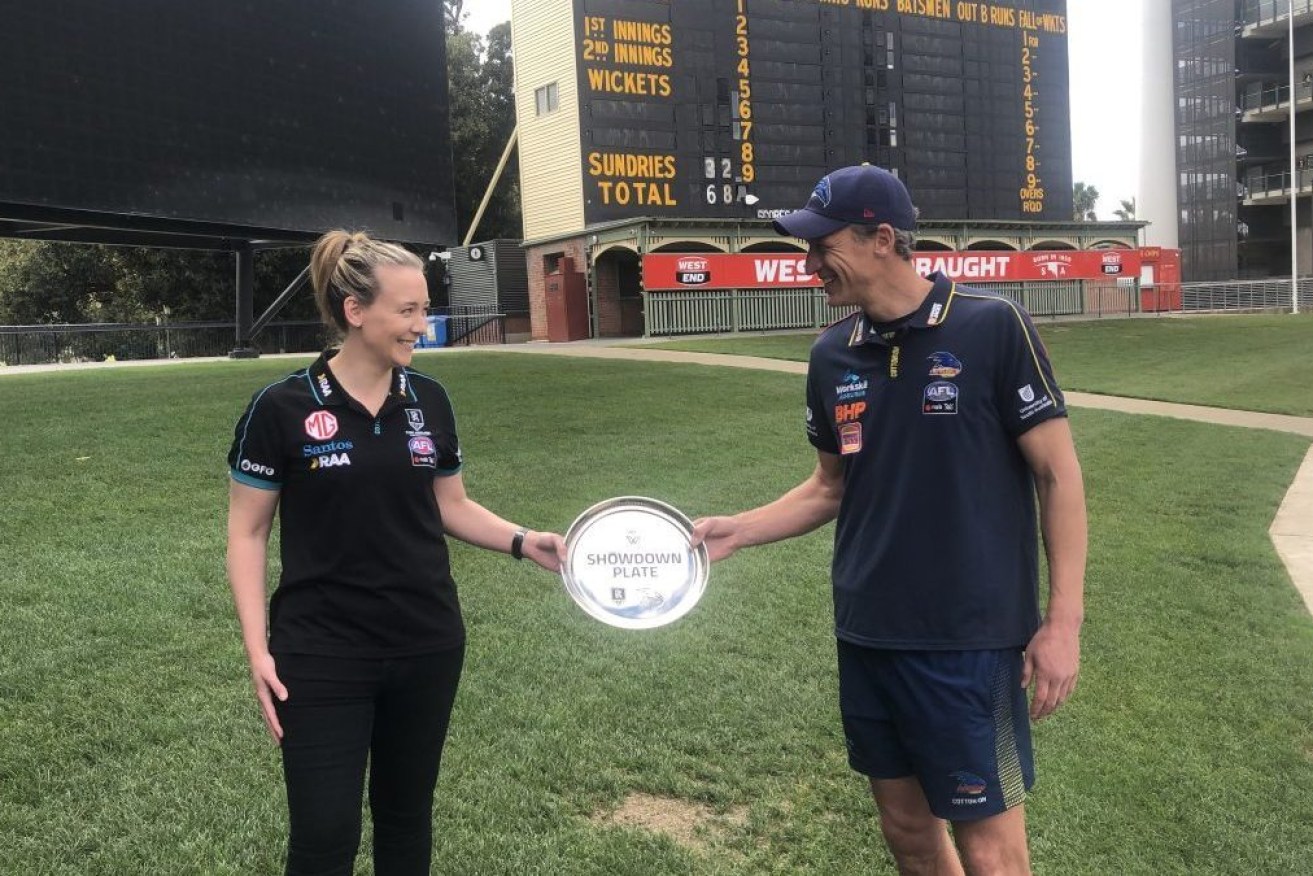
Port Adelaide coach Lauren Arnell and Crows coach Matthew Clarke meet before the historic first AFLW Showdown. Photo: Michelangelo Rucci
Ebony Marinoff was called to AFL House earlier this month for the opening of a time vault holding her pre-draft interviews on the eve of the first AFLW season in 2017.
I looked back … I was so emotional,” says Marinoff, now 24, of seeing the teenager on the verge of becoming a superstar in Australia’s newest and fastest-growing sporting code.
“How is this seven years on? Three premierships. I am pretty much a full-time athlete. And I am playing for the Adelaide Crows …”
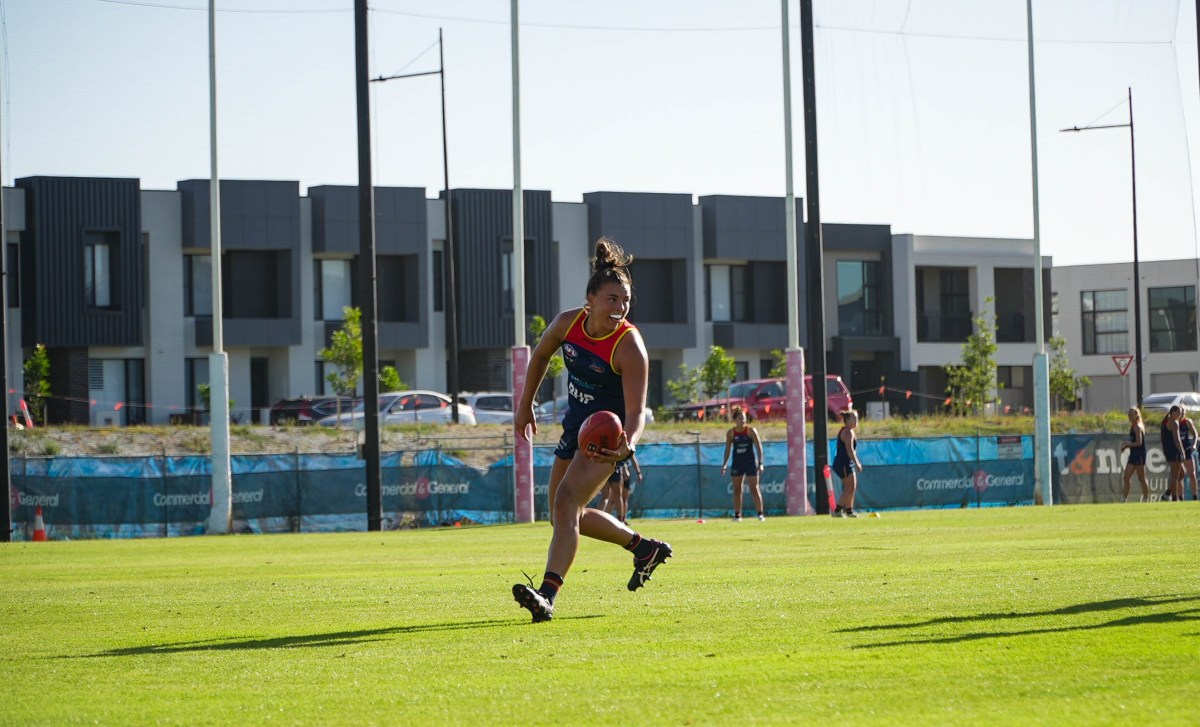
Ebony Marinoff. Photo: Adelaide Football Club
Marinoff shed tears at football’s headquarters in Melbourne while she looked back, in the same way female professional tennis players did 50 years ago to the backdrop of that marketing slogan, “You’ve come a long way baby”. But Marinoff is even more emotional – and provocative – when asked to deliver a forward vision for the AFLW.
The girl who grew up in Adelaide’s western suburbs wanting to be a police officer could become the most-powerful force in fulfilling the women’s game, ala Patrick Dangerfield – Brownlow Medallist, star player, player union president and media performer – in the men’s code.
Marinoff started in a league with eight teams. Today, it is “complete” with all 18 AFL clubs fielding W teams.
The incomplete jigsaw puzzle that is the AFLW gets a significant piece added on Friday evening – the first AFLW Showdown between the well-established and successful Crows, and the newly admitted Port Adelaide team led by former Adelaide captain and Olympian Erin Phillips.
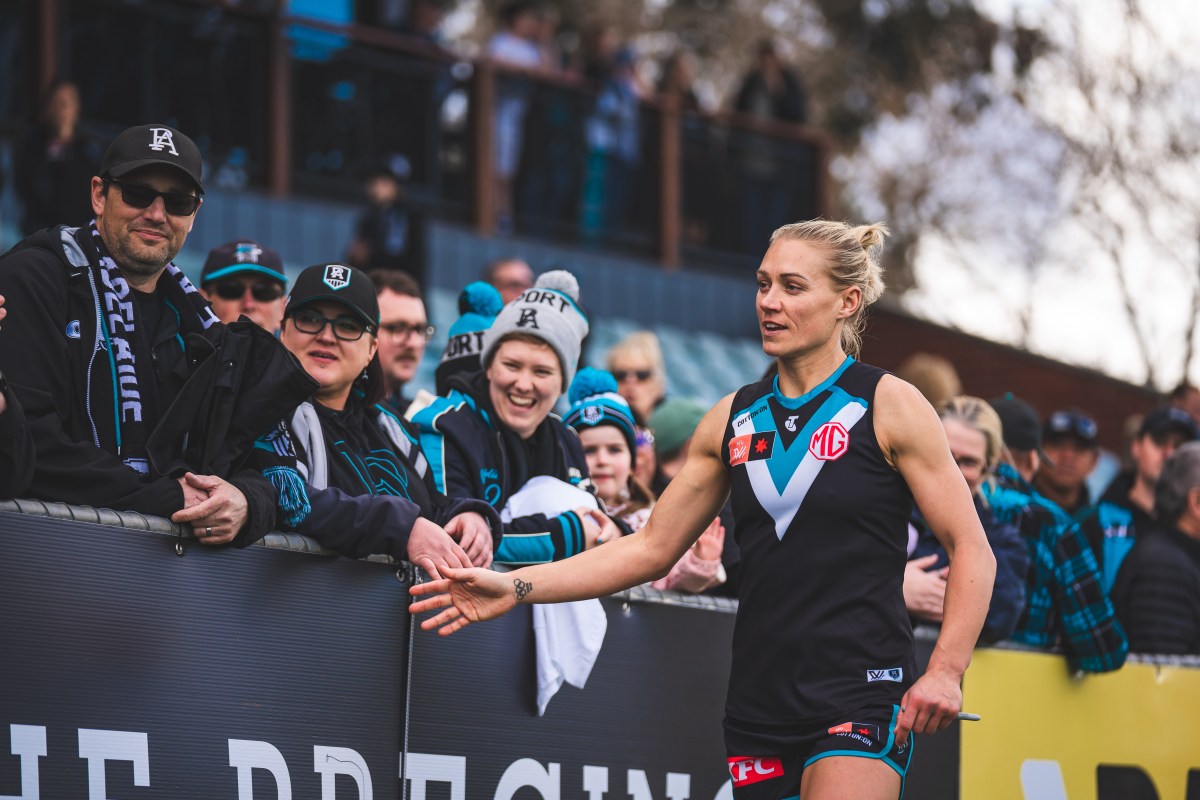
Erin Phillips now sports Port colours. Photo: Port Adelaide Football Club
But there are still many missing pieces for a league that has created significant growing pains, particularly at the grassroots where female players have rushed to community football clubs short of coaches, umpires and critical facilities.
When Marinoff sat before the cameras in 2016, no-one could have imagined what was to unfold with AFL chief executive Gillon McLachlan’s decision to advance the start of AFLW from 2020 to 2017. Now, the hard-tackling, ball-winning Crows midfielder is eager to see the ultimate end game for AFLW … and wary of the potholes in the road for a league that has overwhelmed its start-up custodians.
“We need a vision,” says Marinoff as the AFLW players (and their male counterparts) enter negotiations for a new collective bargaining agreement on the back of the game’s new $4.5 billion television deal to 2031. “It’s the biggest thing as a collective (of AFLW players) – a vision; a committed vision so that we know what the next two-to-five years look like – and a commitment to that vision.”
Marinoff’s agenda is full. There is the fixture. The league’s seventh season has just 10 rounds of home-and-away football for 18 teams, followed by a men’s replica top-eight final series.
“You do need to play everyone once,” says Marinoff. “I can understand what they are saying – it is a lot of money to play these games. It is. We are not making the money they need.
“(But 10 games with 18 teams) does not sit well with me. We have never played Richmond (which joined the AFLW in 2020) until this year. We are not going to play Essendon this season. Or go to Sydney to play the red and white. Or play Hawthorn (that is coached by Adelaide’s inaugural premiership coach Bec Goddard). We don’t get to play Carlton … it is just crazy. I should not be rattling off a long list of teams that we are not going to play.”
There is the question of full-time AFLW players, a concept the players’ union wants sealed in 2026.
“I understand our game has a long way to go,” says Marinoff. “But the more the girls train, the more time they have to learn their game styles; the more time they have to be educated, to train, to kick footballs .. time to work in the gym on their strength and power. They will become better athletes. That is something that is forgotten (when AFLW is compared with AFL) – the men are full time.
“The boys go home at 3. They have a nice nap, have dinner, walk the dog and get a good night’s sleep. Then they are back the next morning for training. We have girls who are doing night shifts. They come to training with fatigue. Their ability to perform at training is not as high as when you are fresh.
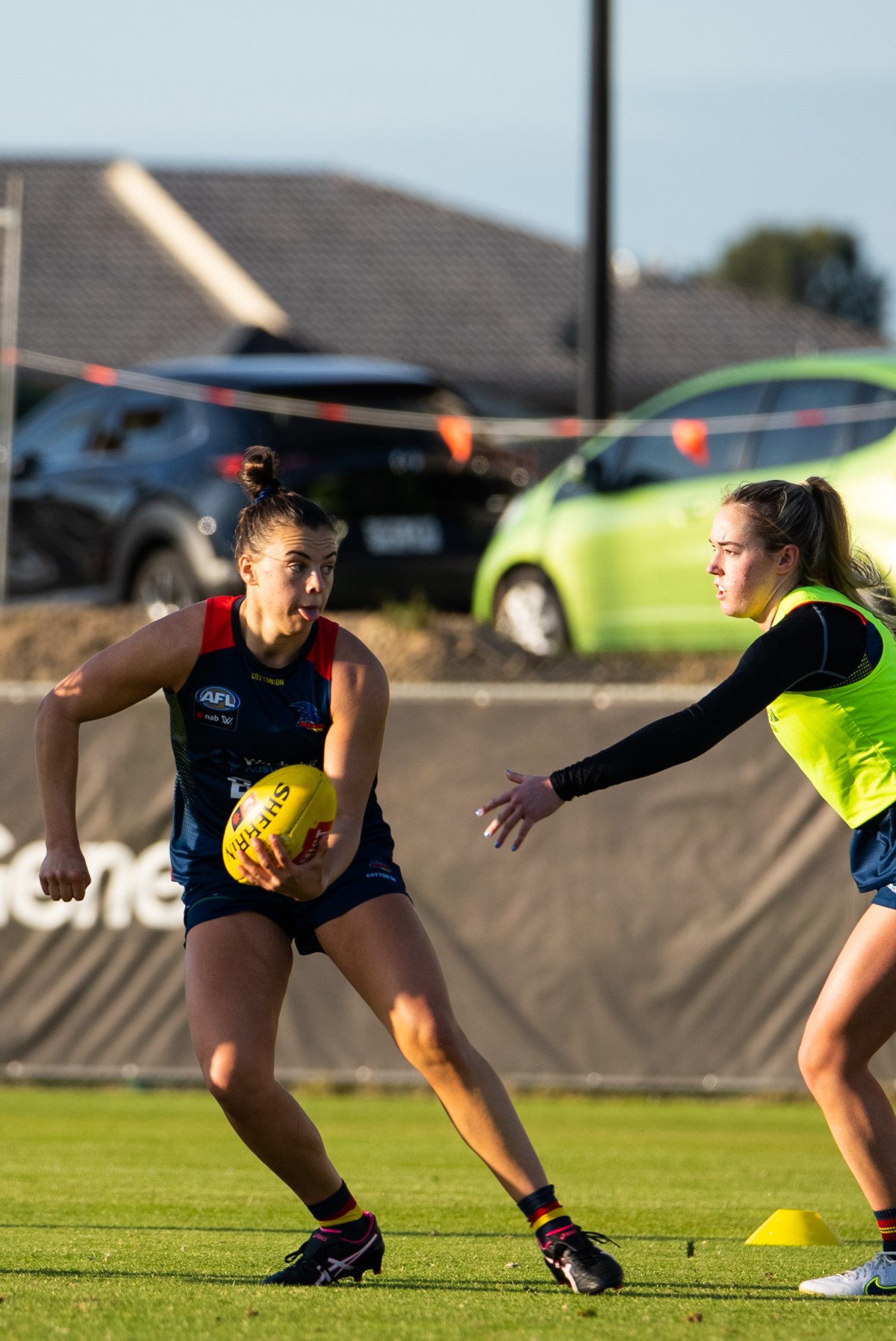
Ebony Marinoff at training. Photo: Adelaide Football Club
“People … they don’t understand that is why our game is not like the men. And I hate it when they are compared. I am also a realist that we have a long way to go to make sure our game is in a good spot when we do go full time. That is a big one – people don’t understand the majority of the girls work 9-5 jobs and then go to training and train for a short amount of time.”
The recent thrashings of the Sydney-based teams – Sydney by 66 points to Port Adelaide at Alberton a fortnight ago and Greater Western Sydney by a league-record 96 points to Adelaide at Unley at the weekend – trouble Marinoff.
“I love 18 teams, but it has been done too soon,” says Marinoff. “There is not enough talent and depth in every state. Does it need to be a national draft? That would have helped Sydney because they could not get players (for an inaugural squad this season). That is the biggest thing at the moment. They should be pushing for a national draft. That is how the men is. That is how these teams get evened out with a national draft. Maybe that is the path we need to go. If not 18 rounds, then a national draft so that we don’t have blowouts.
“There are a lot of things that don’t make sense. I am sure there are reasons. We just have to back it in.”
Marinoff is the last of the generation of five-year-old girls who found Australian football at Auskick clinics and expected to pack away their football boots and collect netball shoes at 12. She followed her older brother Daniel to their family club, Lockleys Football Club.
“Auskick one Friday night and on the Sunday I was playing Grasshoppers for Lockleys, the majority of the time being the only girl in the team,” recalls Marinoff. “Until I was 12. I had accepted it. Done and dusted. You didn’t know any different. You knew that was the time your journey would stop. That was the reality of what the rules were then.
“I was in tears. As a 12-year-old, you just accept you are not going to play the game because you did not know it was a thing. It is weird. I wanted to play. But I did not dream of being a Mark Ricciuto or Andrew McLeod because it was not a reality. You don’t dream that … but now there is the opportunity and I have grabbed it with both hands and had a fun career so far.”
It there as no AFLW or SANFLW, it was to be either netball – where she was going to struggle in a non-contact sport – or surf lifesaving. Naturally ambitious, Marinoff went to St Michael’s secondary college at Henley Beach, setting her goals at earning selection in the State junior netball representative teams.
“And funny enough there was a State schoolgirls team for football, and I did not know that was a ‘thing’ while I was in primary school,” Marinoff said. “That’s when I went to Morphettville Park, because you had to play games to qualify. It was my (football) home for a good four years. And that is where I was drafted from. I was in the under-18 women’s team at 15. I had to get an exemption to play in the open team at 15. Those were my little steps before I was drafted (to the AFLW).”
Little steps taken by Marinoff while carrying big ambition, and no wish to abandon Australian football while the long-standing narrative was the game was not for girls.
“I loved it,” says Marinoff. “I was the player who wanted to get (the football). Contested – I loved the ‘in and under’ stuff. That was just fun. I was not scared of the footy. I was the one going in to get the footy. I just loved that. It was so much fun. I remember as a kid it was something that I loved.
“(Football) is 360 (the play comes from every angle). You don’t know what is going to happen, you don’t know what is around the corner. There is the contested side of it. You get to tackle people. You get to win the footy, be it on the groundballs or someone is coming at you and you get to win a one-on-one contest. You take marks. You get to run … you get to do it all.
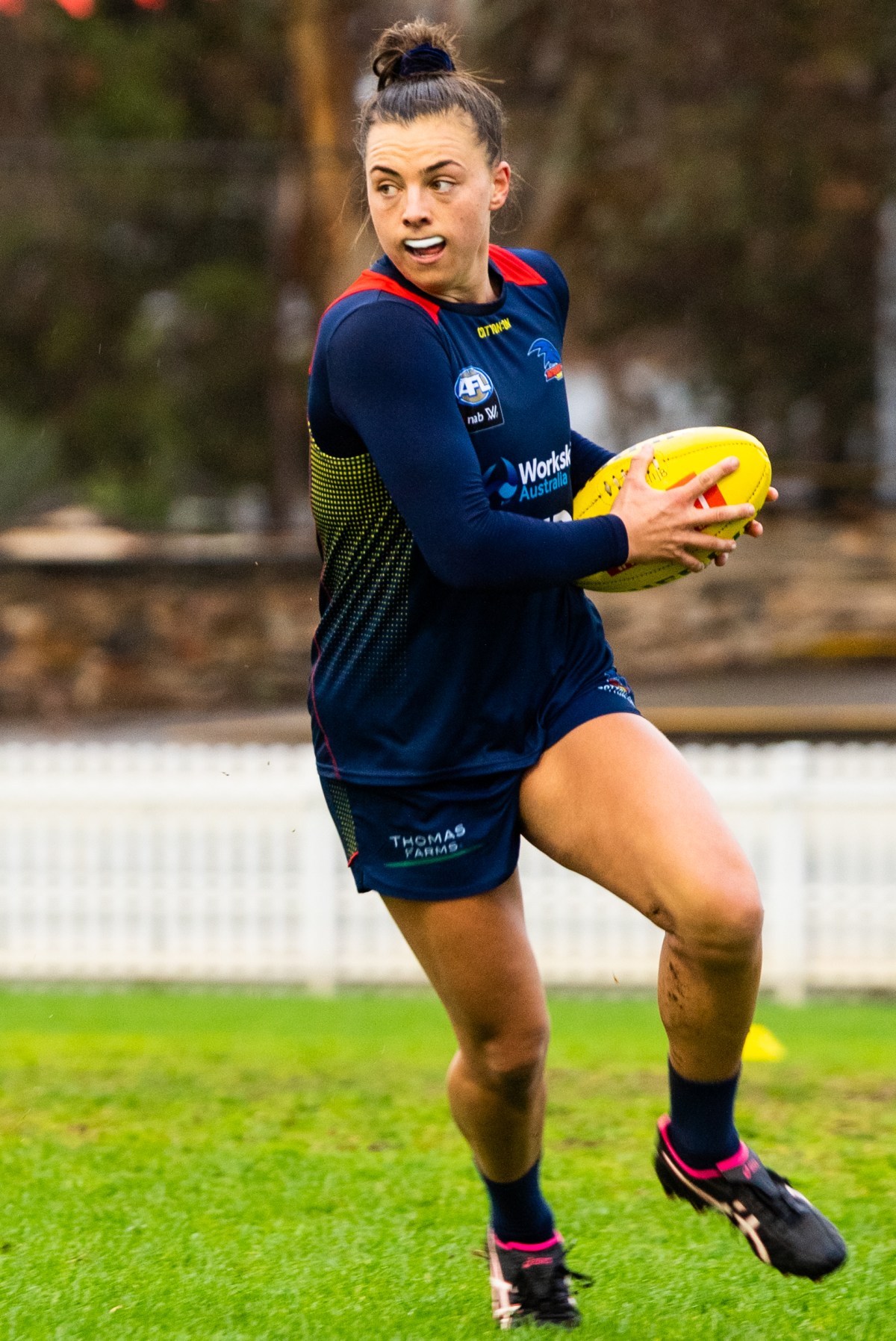
Photo: Adelaide Football Club
“I love everything about it. It is fun and it is hard. I love that is hard. Not always … some games are more fun than others. You have to grind and grit.
“I knew I was the only girl (playing the game at Lockleys), but I never let that get in the way of doing what I loved. Having my dad and my brother within the footy club and mum, it was just normal for us to be around the footy club. It was not that I saw the boys kicking the footy at school and me saying, ‘I want to do that’. I grew up at the Lockleys Football Club, from a baby. I remember it being part of family life – and me loving it.”
From Lockleys to the uncertain years as a teenager wanting to play Australian football, Marinoff thought the pinnacle of the women’s game was the annual Hamspon-Hardemon Cup played between the Melbourne and Western Bulldogs (Footscray) clubs.
And then someone said there was going to be this AFLW. My reaction was, ‘Is this a thing?’,” Marinoff told InDaily. “A women’s league in 2020? That sounds cool. As soon as I found out that league was coming in 2017, I remember working really hard – 10 of us South Australians who played State footy went to (local pioneer) Narelle Smith for a good 18 months.
“We trained at the uni loop. We would do testing and we were pushed really hard. I kept thinking, this AFLW is happening and we all wanted to be prepared. Then the question was, ‘Will SA have a team?’ The 10 of us could have gone anywhere. I made sure I grabbed that year with both hands. It was a really good year. It all happened from there. I nominated for the SA section of the draft – first picked in the first draft.”
Soon-to-depart AFL boss Gillon McLachlan’s legacy to Australian football is summed up in Marinoff’s story.
I’m one of the lucky ones … really lucky,” says Marinoff who feels her AFLW career is a reward for “hard work – not talent”.
“It was the middle of the school year, my year 12 (of studies) when I knew there was going to be a league. That is what I want to do, I thought. There is a photo at my year 12 graduation. We were asked, ‘What do you want to do when you graduate?’ Be drafted to AFLW! That was my goal. I had two years to make sure I was drafted.
“I had a gap year – and I put all my eggs in one basket. I wanted to play footy. I was part-time at the netball stadium (at Mile End) when it was ETSA Park and at Foodland Fulham in the deli department slicing ham and prosciutto for all the Italians who live in Fulham and Fulham Gardens. I was committed to making sure I was drafted. I wanted to make sure I was the best player I could be. Nothing else mattered.
“I was keen to be a cop, maybe even go to uni and do sports management or events. Seven years on, I am in my seventh gap year and my seventh season of AFLW. I am fully absorbed in footy. The girls will tell you I cannot sit still – except to watch Home & Away, that is it.”
Showdown WI on Friday night is played 25 years after the first men’s derby at Football Park. Marinoff comes from the Crows side of the great divide in South Australian football.
“I remember sitting at Football Park with my poppa Jim, eating hot dogs watching my favourite player Jason Porplyzia … and Ben Rutten, Kurt Tippett, Bernie Vince Jared Petrenko, Nathan van Berlo. And this is when you pinch yourself – I am going to play in a Showdown at Adelaide Oval,” says Marinoff.
“As a South Australian, it is amazing growing up watching the rivalry. Oh wow, I am going to be a part of that. As a kid you go to Showdowns. As a teenager at high school, your friends have a barbecue to watch the Showdown. It is one of the biggest sporting days – if not the biggest – for our State. The fact we get to go out on Adelaide Oval and begin a new chapter in one of the richest rivalries in the game, not just in our State, that is really cool.
“This is a pivotal moment for the sport as well. I don’t think there is a bigger rivalry in the game. As South Australians we know that. The AFL is starting to understand what the rivalry is all about. It is awesome we get to start something pretty cool. Hopefully, we pack it out, we get the crowd and their energy behind it. I can only imagine the passion shown by both teams.”
The men’s rivalry has taken a harsh tone, particularly from Port Adelaide.
“I watched the last Showdown. That was not good. There is this sense of hate and emotion,” said Marinoff who heard the Port Adelaide leadership group define the Crows as “arrogant and entitled”.
How does this translate to the AFLW Showdown rivalry?
“I am not sure you can use those words with us,” says Marinoff. “They have Erin (Phillips) who leaves with an incredible legacy at our football club. She loved her time here. And she had some success; a lot of success. They also have Ange Foley and Justine Mules.
“They look weird in black. I don’t know what will happen. Justine is the chirpiest. Erin just goes to business. I have learned that from Erin – as soon as you cross the line, it is white-line fever and you go to work. There is no trash talk from us. We are mute. Ange and Justine are chirpy. It is fun and games talking about it now but when you cross that white line we are there to win the game.”
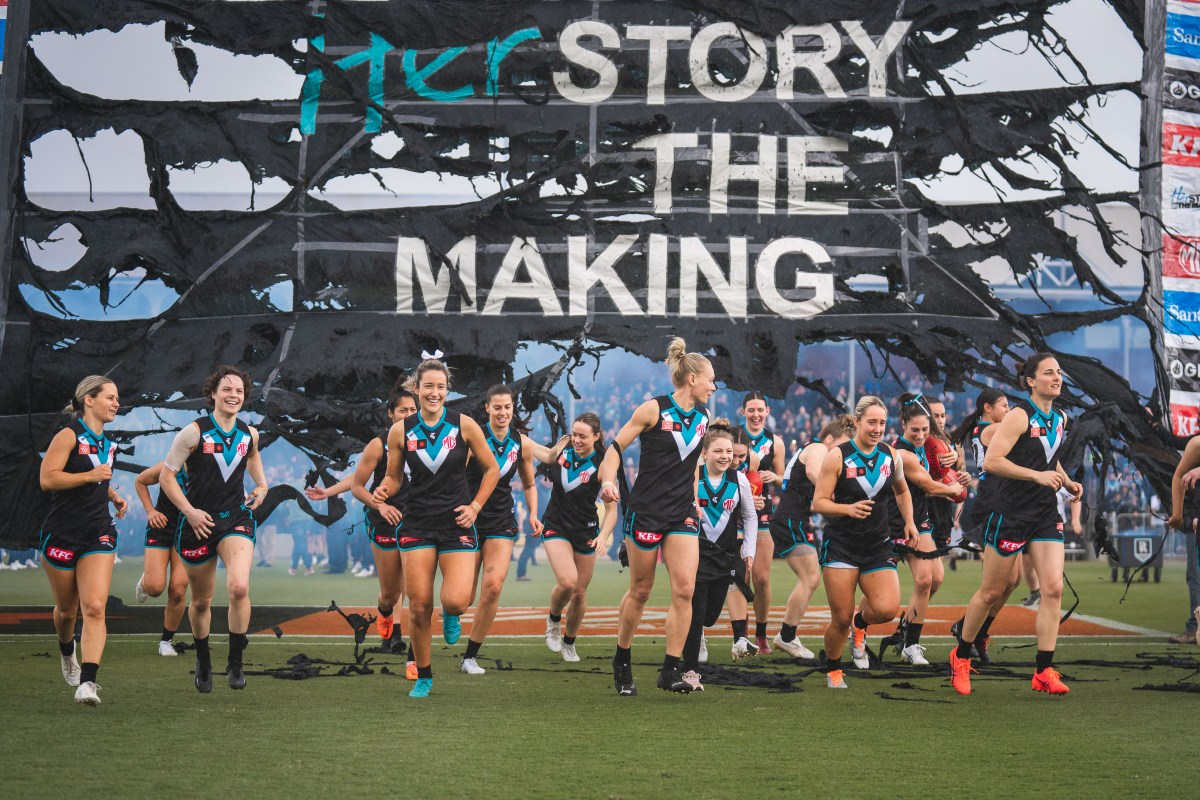
Photo: Port Adelaide Football Club
“They all left with full hearts from our football club. We don’t have girls who had bad experiences. We are fortunate that the culture we built from day dot ensured our girls left knowing they would always be welcomed back with open arms. So it is a bit different. Maybe (Port Adelaide) will roll with it. I don’t doubt (those thoughts) have been embedded in them, as to how they look at us. A club has a vision. Everyone needs to be on the same page. One in all in, we say.
“This game has been in everyone’s diaries since the fixture came out. I can’t wait. There is no denying the occasion and the build up. We have played in some big and important games, so we know how to handle a big occasion. We will soak it all up. As soon as we cross that line we will want our names going into the history books.
“There always is that talk going into the Showdown of how you have lost the last three or you have to get them back. Or who is leading in the Showdown tally. Those little things bring energy into the game during the week – and we get to start that for the AFLW now. In five, 10 years time they will be talking about the ledger in our Showdowns too.”
And Marinoff will be talking – in bigger circles – of the bigger picture of how the AFLW stands on its own feet.
“I hope so; I love footy,” says Marinoff. “I go through waves … do I want to be a coach? Development? Footy administration? I love going downstairs helping organising things for our away games or our weekly schedule. I hope I stay in footy. Maybe media? I love analysing games …”
Marinoff’s analysis of the AFLW’s growing pains might prove critical to completing the puzzle for women’s football.




